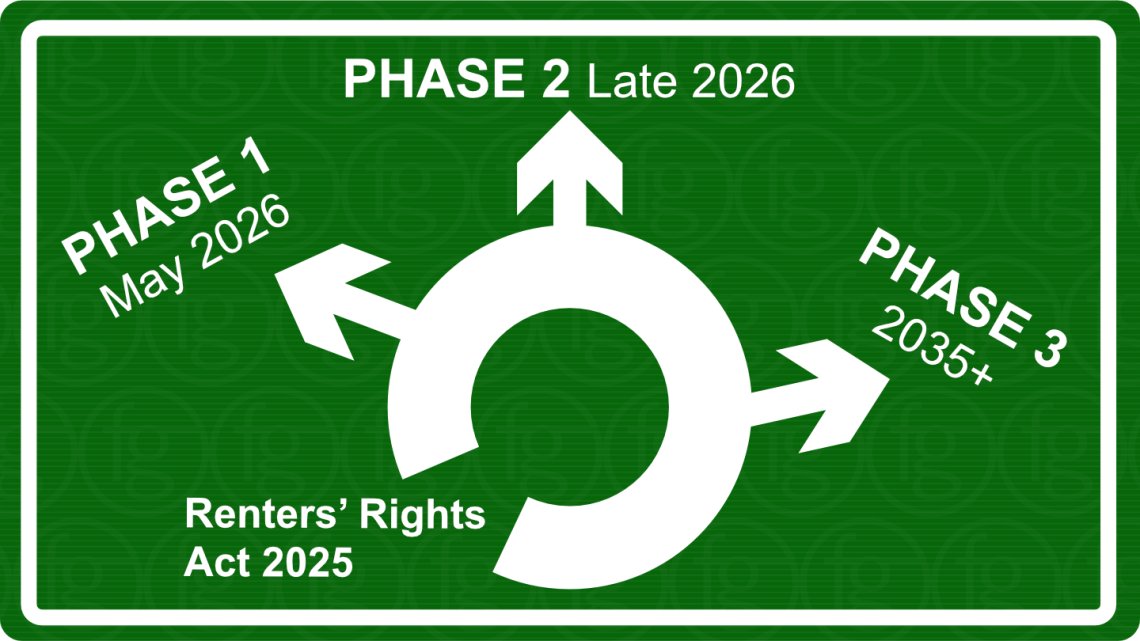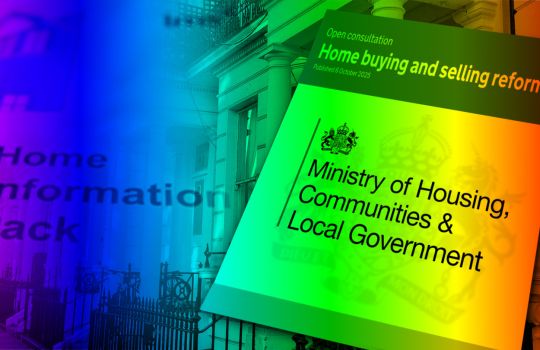The Road To Renters Rights

In a sweeping reform of the private rented sector (PRS) in England, the Ministry of Housing, Communities & Local Government (MHCLG) has published a detailed implementation roadmap for the Renters’ Rights Act 2025, setting out a three-phase schedule through to the mid-2030s.
What’s changing and why
According to the MHCLG, the Act is designed to “transform the experience of private renting” by giving renters greater security and rights, improving the quality of rented homes, and strengthening enforcement against unscrupulous landlords. The reforms follow widespread criticism that the PRS has become too insecure, poorly regulated and of inconsistent quality.
Phase 1 – Taking effect from 1 May 2026
The first and most immediate tranche of reforms will come into effect on 1 May 2026, with preparatory enforcement powers starting on 27 December 2025. Key measures include:
- Abolition of “no-fault” evictions under Section 21: landlords will no longer be able to evict tenants without reason.
- Migration to Assured Periodic Tenancies: fixed-term tenancies will largely be replaced by rolling contracts, giving tenants greater security.
- Reform of possession grounds (Section 8): balancing tenant protections with landlord rights to regain properties on fair grounds.
- Limit on rent increases: once per year under revised Section 13 notices, with at least two months’ notice.
- Ban on rental bidding wars: landlords and agents cannot solicit or accept offers above the advertised rent.
- Cap on rent in advance: no more than one month’s rent may be requested upfront.
- Expanded anti-discrimination protections: landlords/agents cannot discriminate against tenants because they receive benefits or have children.
- Right to request a pet: landlords must respond within 28 days and provide valid reasons if refusing.
- Strengthened enforcement powers for councils: enhanced investigatory powers from 27 December 2025.
Impact and reaction:
For tenants, Phase 1 represents a major shift - more security, fewer arbitrary evictions, and new rights. For landlords and agents, the lead-in period is intended to allow adjustment, but industry bodies such as the NRLA warn that without timely guidance, implementation could falter.
| Feature - scroll to continue with content... |
| continue reading article... |
Phase 2 – From late 2026 onwards
The second phase will focus on accountability and transparency:
- Introduction of a PRS Database: mandatory registration for all landlords, capturing property details, safety compliance, and contact information.
- Roll-out in two stages: regional pilots from late 2026, followed by national rollout with public access and data-sharing with councils.
- Establishment of a mandatory Landlord Ombudsman for the PRS: landlords will be required to join the ombudsman scheme, which will provide a redress channel for tenants and also support landlords via guidance and training. Implementation is expected to be around 2028.
Impact and reaction:
Phase 2 aims to give tenants more transparency and more accessible dispute-resolution avenues outside court. For landlords, registration and oversight will come with cost and compliance obligations, but for the sector it may lead to improved standards and reputation.
Phase 3 – Dates to be confirmed (consultation proposes either 2035 or 2037)
The final phase addresses quality of housing and enforcement of minimum standards. Key measures include:
- Introduction of a new Decent Homes Standard (DHS) for the private rented sector: privately rented homes will legally have to meet minimum quality and safety standards, with local councils empowered to enforce.
- Extension of Awaab’s Law to privately rented homes: setting legally enforceable timeframes for landlords to remedy serious hazards (for example damp, mould). A consultation on timing and detail is ongoing.
The government has proposed either 2035 or 2037 as the deadline for full implementation of the DHS in the PRS but has indicated that landlords are encouraged to act sooner where feasible.
Impact and reaction:
While seen as vital for raising housing standards, some critics argue the long lead time dilutes the immediacy of the reform. Nonetheless, Phase 3 signals the government’s intent to shift from security/rights (Phases 1 & 2) to quality of accommodation as a central concern.
| Feature - scroll to continue with content... |
| continue reading article... |
Implementation support & “getting ready”
The roadmap identifies support measures to help the sector prepare. Guidance for landlords will be published in November 2025; tenant-focussed guidance in April 2026. Funding has been provided to local housing authorities (£18.2 million allocated in 2025/26) to build capacity for enforcement. The government also intends to monitor and evaluate the reforms, with evaluation reviews at two and five years post implementation.
Key dates at a glance
27 Oct 2025: Royal Assent of the Renters’ Rights Act 2025.
27 Dec 2025: Enhanced investigatory and enforcement powers for councils come into force
01 May 2026: Phase 1 reforms come into effect.
Late 2026: Phase 2 begins: rollout of PRS Database and preparation for Landlord Ombudsman.
2028: Expected date for mandatory Landlord Ombudsman membership.
2035/2037: Target for introducing Decent Homes Standard and Awaab’s Law in PRS (subject to consultation).
Challenges and industry reaction
Although broadly welcomed by tenant-advocacy groups, the reform faces several challenges:
- Sector preparedness: The NRLA argues the notice period is too tight and that essential guidance and regulations are still missing.
- Enforcement capacity: Councils will need sufficient resources and training to enforce the new rules effectively - a concern flagged in the roadmap itself.
- Long-term timeline for standards: Some landlords and tenants are critical of the slow pace for Phase 3 (2035/37) given urgent quality issues in the sector.
- Impact on supply & investment: Some investors argue the increased regulatory burden may affect willingness to rent property, potentially reducing supply and increasing costs for tenants.
- Tenant awareness: Despite the rights being introduced, tenants will need to know about them and how to navigate them - communications and advice services will be vital.
What this means for tenants and landlords
- For renters: From May 2026, expect rolling tenancies, protection from no-fault evictions, annual rent increase limits, pet-request rights, and anti-discrimination safeguards.
- For landlords: Prepare to update agreements, register on the PRS Database, join the Ombudsman, and comply with stricter standards.
- For agents and councils: Transition to new processes, data-sharing, and enforcement regimes.
In Summary
The roadmap for the Renters’ Rights Act 2025 outlines one of the most ambitious overhauls of the English private rented sector in decades - shifting from a system of fixed-term tenancies and “no fault” evictions towards one of longer-term security, tenant rights, transparency and housing quality. As the countdown to May 2026 begins, all stakeholders - tenants, landlords, agents and councils - must engage now to be ready for the transformation ahead.
Link to Government publication for roadmap to implementation of the Renters' Rights Act 2025
This article is intended as a general guide for informational purposes and will be updated as further details become available. Always seek professional advice before making any property and/or financial decisions.
Related Reads
November 2025: https://www.fullergilbert.co.uk/renters%E2%80%99-rights-act-and-section-8
October 2025: https://www.fullergilbert.co.uk/renters-rights-bill-ready
April 2025: https://www.fullergilbert.co.uk/renters-rights-bill-invokes-lively-committee-debate
April 2025: https://www.fullergilbert.co.uk/renters-rights-bill-scrutinised
March 2025: https://www.fullergilbert.co.uk/leasehold-system-reforms-move-a-step-closer
Jan 2025: https://www.fullergilbert.co.uk/renters-rights-bill-progresses
Click here for the Government's guide to the Renters’ Rights Act
















